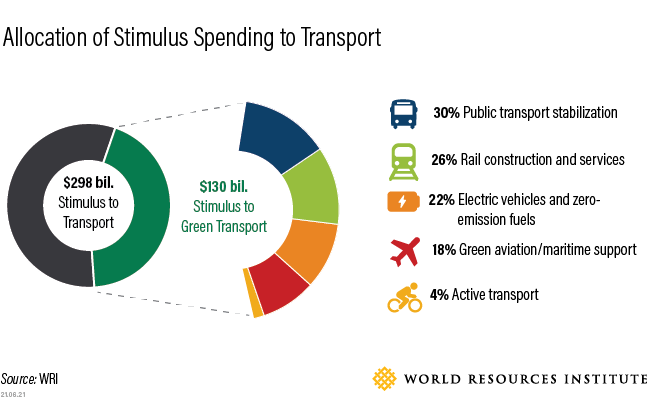If you would like to know more about the types of cookies we serve and how to change your cookie settings, please read our Cookie Notice.
The global coronavirus pandemic brought a wave of public and private initiatives to help societies adapt and recover, from economic stabilization and safety measures to new business models and shifts in consumption.
Transport is a key sector in need of big changes, comprising 14% of global greenhouse gas emissions and 24% of carbon emissions.
In a new paper with the Transport Decarbonisation Alliance, WRI evaluated countries’, cities’ and companies’ actions during the pandemic that impact the transport sector.
Hundreds of cities — including Lima, Paris and Addis Ababa — are adding new bicycle and walking facilities as pandemic safety measures.
Between October 2020 and February 2021, business members of the EV100 initiative deployed 89% and 23% more passenger and commercial vehicles, respectively, and installed 79% more charging stations compared to the year prior.
But as countries, cities and companies continue to shift their strategies to longer-term recovery from short-term stabilization, there is significant work to be done to get the world on track for a resilient, net-zero future.
Public transport ridership and revenues collapsed globally during the pandemic, forcing many agencies to cut services and raise fares.
Investing in public transport improves equal access to jobs and services, road safety, smart urban growth and limits carbon emissions.
Many locales have a withstanding need to reimagine public transport as the backbone of urban mobility, grounded in reliable funding, better governance and focus on access to jobs, education and services.
Delhi introduced mobile payment options on 650 buses and issued over 200,000 tickets in a matter of three months of its initial pilot in the last year.
Bogotá, Colombia, which created 84 km of emergency bicycle lanes, announced a plan to add an additional 280 km to their existing 550 km network within four years.
The International Council on Clean Transportation found governments that instituted the highest fiscal incentives immediately following the 2008 Great Recession — including the governments of Norway, California and The Netherlands — achieved the largest increases in EV market shares in the years that followed, though some programs had a blind eye to middle and low-income consumers.
To put that in perspective, the United States alone will need $4.7 billion in charging infrastructure investment to meet demand over the next five years, resulting over 56,000 jobs.
One local bus company found operational and maintenance costs were 70% and 37% cheaper, respectively, than with former diesel buses.
During the Great Recession, 26% of global green stimulus funds went to rail, making it the largest category of green stimulus investments across sectors.
Whether from the public or private sector, recovery investments in rail should be green with mode shift and efficiency in mind.
Meanwhile, cities in China and India are shifting goods from truck beds to boxcars, saving on emissions and improving local air quality.
Hundreds of top bank officials, economists and finance ministers voted clean R&D a class favorite among other stimulus investments for having the highest long-term climate impact.
A swift return to business as usual could cause aviation to consume up to 27% of the global carbon budget in a 1.5 degree C by 2050 scenario.
As countries prepare plans to raise their climate ambitions ahead of COP26, choices in how to spend trillions in stimulus money will have long-lasting effects.
Enacting these five recommendations together will create a plethora of benefits, including job creation, road safety, improved air quality, revitalized economies and so much more.
